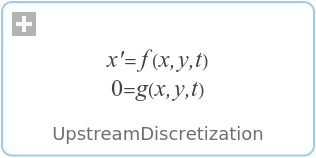WOLFRAM SYSTEM MODELER
UpstreamDiscretizationUpstream discretization |
|
Wolfram Language

SystemModel["Modelica.Fluid.UsersGuide.ComponentDefinition.UpstreamDiscretization"]

Information
This information is part of the Modelica Standard Library maintained by the Modelica Association.
When implementing a Fluid component, the difficult arises that the value of intensive quantities (such as p, T, ρ) shall be accessed from the upstream volume. For example, if the fluid flows from volume A to volume B, then the intensive quantities of volume B have no influence on the fluid between the two volumes. On the other hand, if the flow direction is reversed, the intensive quantities of volume A have no influence on the fluid between the two volumes.
In the Modelica.Fluid library, such a situation is handled with the following code fragment (from Interfaces.PartialTwoPortTransport):
replaceable package Medium = Modelica.Media.Interfaces.PartialMedium
annotation(choicesAllMatching = true);
Interfaces.FluidPort_a port_a(redeclare package Medium = Medium);
Interfaces.FluidPort_b port_b(redeclare package Medium = Medium);
Medium.ThermodynamicState port_a_state_inflow
"Medium state close to port_a for inflowing mass flow";
Medium.ThermodynamicState port_b_state_inflow
"Medium state close to port_b for inflowing mass flow";
equation
// Isenthalpic state transformation (no storage and no loss of energy)
port_a.h_outflow = inStream(port_b.h_outflow);
port_b.h_outflow = inStream(port_a.h_outflow);
port_a.Xi_outflow = inStream(port_b.Xi_outflow);
port_b.Xi_outflow = inStream(port_a.Xi_outflow);
// Mass balance
port_a.m_flow + port_b.m_flow = 0;
// Medium states for inflowing medium
port_a_state_inflow = Medium.setState_phX(port_a.p, port_b.h_outflow, port_b.Xi_outflow);
port_b_state_inflow = Medium.setState_phX(port_b.p, port_a.h_outflow, port_a.Xi_outflow);
// Densities close to the parts when mass flows in to the respective port
port_a_rho_inflow = Medium.density(port_a_state_inflow);
port_b_rho_inflow = Medium.density(port_b_state_inflow);
// Pressure drop correlation (k_ab, k_ba are the loss factors for the two flow
// directions; e.g., for a circular device: k = 8*zeta/(pi*diameter)^2)^2)
m_flow = Utilities.regRoot2(port_a.p - port_b.p, dp_small,
port_a_rho_inflow/k1, port_b_rho_inflow/k2);
The medium states for inflowing media can be used to compute density and dynamic viscosity which in turn can be use to formulate the pressure drop equation. The standard pressure drop equation
dp = port_a - port_b;
m_flow = sqrt(2/(zeta*diameter))*if dp >= 0 then sqrt(dp)
else -sqrt(-dp)
cannot be used, since the function has an infinite derivative at dp=0. Instead the region around zero mass flow rate must be regularized using one of the regularization functions of Modelica.Fluid.Utilities. This requires to have density and/or other medium properties for both flow directions at the same time. These media properties can be computed from the medium states of the inflowing fluid at the two ports.
If the above component is connected between two volumes, i.e., the independent medium variables in port_a and port_b are usually states, then port_a.h and port_b.h are either states (i.e., known quantities in the model) or are computed from states. In either case they are "known". In such a situation, all equations can be directly evaluated without any problems. Zero or reversed mass flow rate does not pose any problems because the medium properties are always computed for both flow directions and are then used in the regularization function.
If 3 or more components are connected together, it can be shown that a system of non-linear algebraic equations appear. The equations are written by purpose in such a form, that a tool can select mass flow rates and pressures as iteration variables of this system. The advantage is that these iteration variables are continuous and even often differentiable. The alternative to use the medium states as iteration variables is not good, because T,h,d are discontinuous for reversing flow direction.
